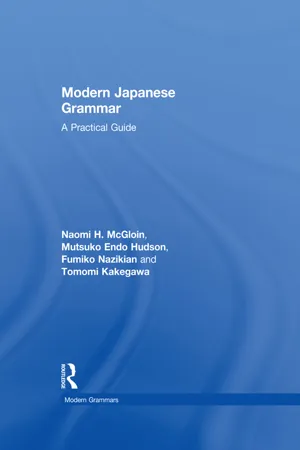
- 394 pages
- English
- ePUB (mobile friendly)
- Available on iOS & Android
About This Book
First published in 2013. As with its series counterparts, this is an innovative reference guide to the Japanese language, combining traditional and function-based grammar in a single volume.
In its two-part structure, Part A covers traditional grammatical categories, such as structural features of the language and the behaviour of parts of speech. With a strong emphasis on contemporary usage, all grammar points are richly illustrated with examples written in a combination of hiragana, katakana and kanji, alongside romanizations and sentence meanings in English.Part B is organised around language functions such as expressing likes and dislikes, giving and seeking information, making decisions and apologising. This function-based presentation is an invaluable guide to the situationally-appropriate use of Japanese for learners at all levels.
The two parts of the Grammar are closely linked by extensive cross-references, providing a grammatical and a functional perspective on many patterns in the language. This is the ideal reference grammar for learners of Japanese at all levels, from novice to advanced. No prior knowledge of grammatical terminology is assumed and a glossary of grammatical terms is provided.
Frequently asked questions
Information
Part B
Functions
I
Social interaction and communication strategies
30
Social interaction
30.1 Determining the style
- Informal style: To family members, close friends and colleagues, and children
- Formal style: To social superiors and acquaintances.
- • Fragmented with many incomplete sentences and omissions.
- • Interactive, accompanied by interactive particles (e.g. ne, yo), fillers (e.g. anoo ‘um’), and listener responses (called aizuchi; e.g. hai ‘yes’).
- • Full of contractions (e.g. ik-anaku-cha ¬ ik-anaku-te wa ‘I must go’).
- • The word order may be switched around, and subject, object, time and place words, etc. may appear after the verb, as opposed to the canonical subject–object–verb order.
Table of contents
- Cover
- Title
- Copyright
- Contents
- Introduction
- Acknowledgments
- Glossary of grammatical terms
- Abbreviations and symbols
- Notes on romanization
- Part A Structures
- Part B Functions
- Appendix I: Hiragana charts
- Appendix II: Katakana charts
- Appendix III: Verb basic conjugation table
- Appendix IV: Copula and adjective basic conjugation table
- Bibliography
- Index